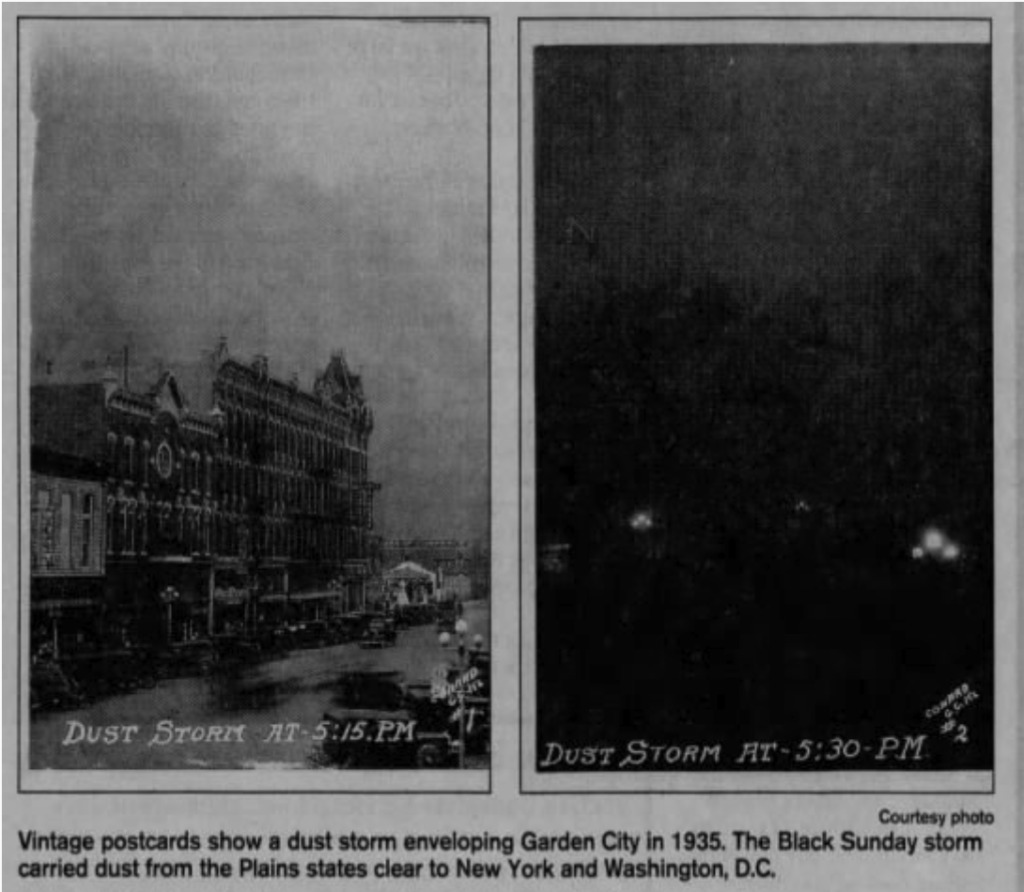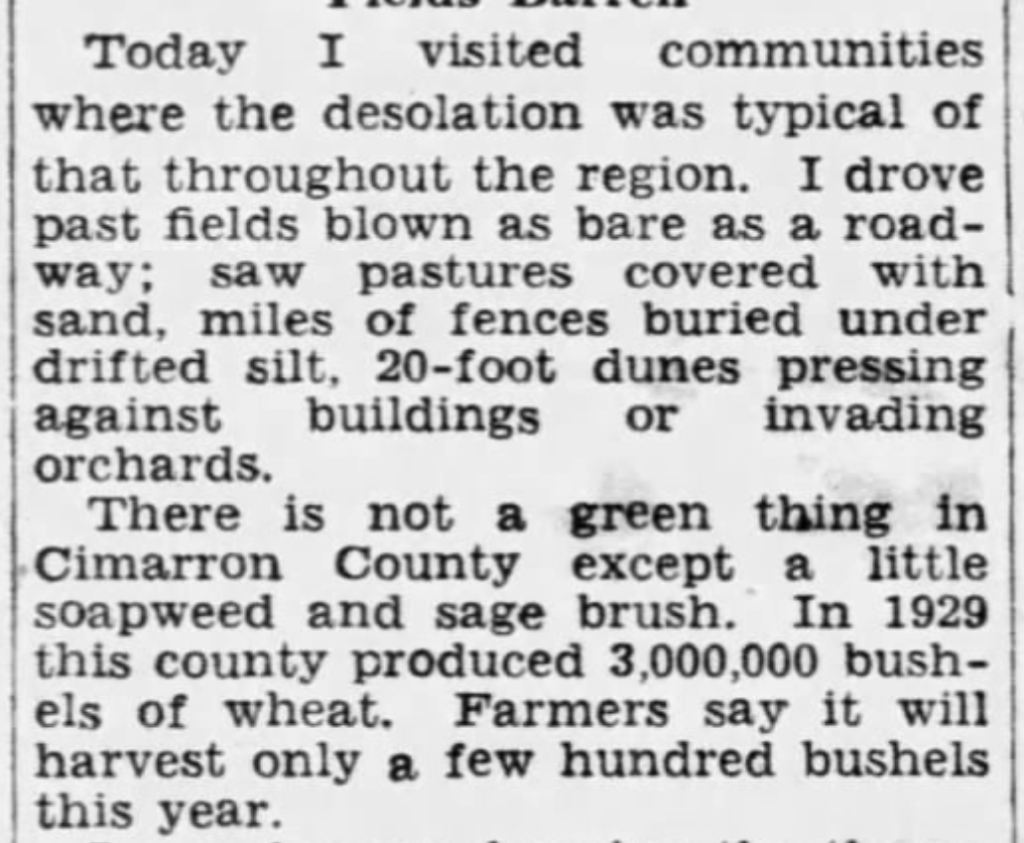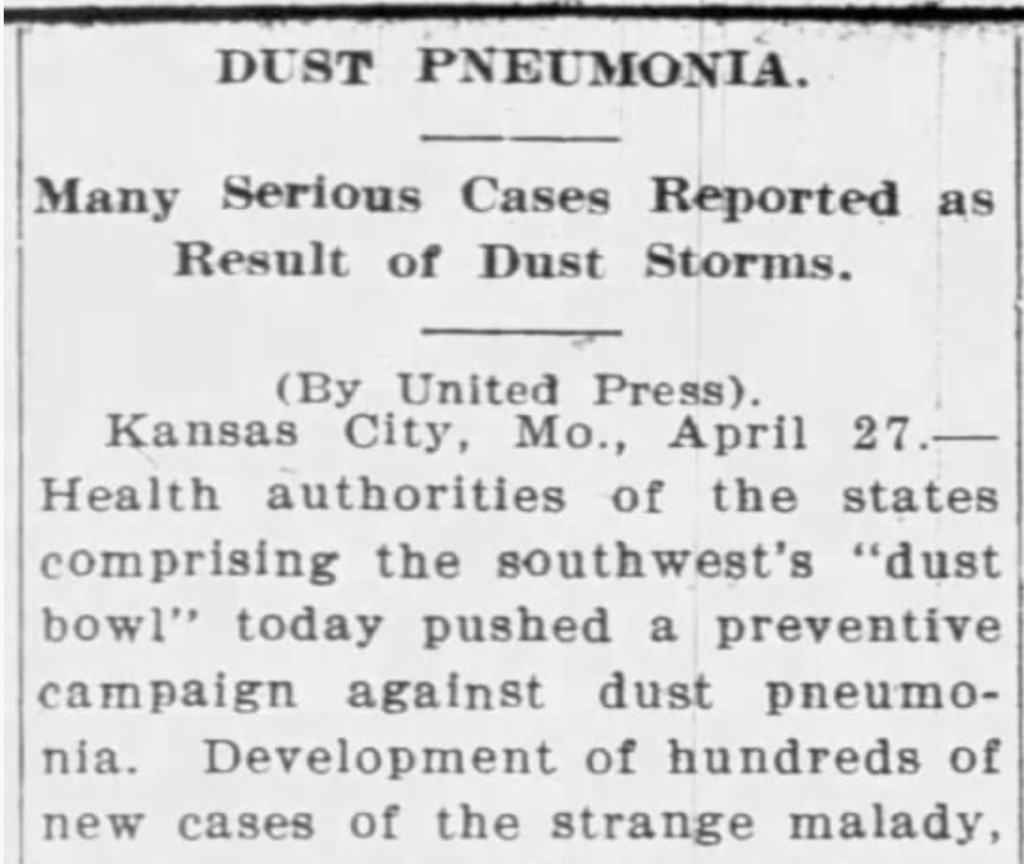On April 14, 1935, a massive black cloud of dust rolled across several states, including Oklahoma, Kansas, Colorado, New Mexico, and Texas. The wall of blowing sand and dirt coated everything, turning day into night and reducing visibility to near zero. The storm was the worst single storm of the Dust Bowl and resulted from years of drought and poor land management practices. The storm, known as the Black Sunday storm, resulted in the loss of crops and livestock and led to human fatalities from “dust pneumonia.”
The 1930s Dust Bowl came on the heels of the Great Depression, bringing misery to already suffering Americans. It was triggered by nearly a decade of drought and over-cultivation in the Great Plains. The native grasses that previously held the topsoil in place were eliminated, leaving the topsoil exposed and vulnerable to winds.
On the afternoon of April 14, a storm blasted the Oklahoma panhandle. Temperatures dropped quickly, and strong winds picked up loose topsoil. The winds carried the sand and soil particles across several states, picking up more dust as the storm churned. Lucian Doll, 14, was working on a Kansas farm when he noticed black clouds along the horizon. With a wall of dust quickly approaching, Doll unhooked his horse team and ran the animals a quarter mile to the barn. He reached the stable just as the dust cloud enveloped him. After securing the horses, he couldn’t see the house 50 yards away. When the storm finally passed, Doll went out to investigate the aftermath. He was shocked to find crops reduced to stubble and dead cattle standing upright, their lungs filled with dirt. “I thought the world was coming to an end,” he said.
Another witness described roads buried two feet deep, sand covering fences, and 20-foot dunes pressing against buildings. Associated Press reporter Robert Geiger and a photographer were driving in Oklahoma and saw the storm approaching. They raced at 60 miles an hour, trying to outrun the black cloud, but it overtook them. The following day Geiger filed a report and used the term “dust bowl” to describe their experience. He is credited with giving the Dust Bowl era its official name.
Dust from the Black Sunday storm worked its way into homes through every crack and crevice, coating every surface. One survivor remembers how they set dinner plates upside down on the table to prevent them from getting dusty. They turned over the dishes when the food was ready, but everything still tasted gritty.
With so much dust in the air, it was hard to avoid breathing it in. Officials urged people to wear masks, but many became sick and developed pneumonia. Hundreds and possibly thousands died. Following this destructive dust storm, Congress passed the Soil Conservation Act on April 27, 1935. The Act aimed to help landowners and government agencies maintain healthy and productive working landscapes.
The National Weather Service ranks the Black Sunday storm as one of the most significant events of the 20th century. If you would like to learn more about the storm, search Newspapers.com ™ today. In addition, see curated clippings about the Dust Bowl in our Newspaper.com Topic Pages.





My mom had family in Kansas and Oklahoma (Cimmarron strip). They talked about not being able to see the house from the barn. Cars stripped of paint to the metal. She was a young kid. My dad was a bit older and grew up in the thirties. He also talked about running a line from the house to the barn in South Dakota because they couldn’t see far in the dust. But the dust storms aren’t what the people that lived through the thirties talk about. It is the drought. Day after day of no rain. Hopes dashed for crops that wouldn’t grow. I grew up understanding how precious water is in the west. How rain is fickle and snowmelt is so important. How lack of snow is a bad omen. My uncle, who bought out my dad’s father on the ranch he grew up on, returned the property to native grass for the cattle to graze on. No till farming also helps. But nothing replaces the lack of rain. When I visit relatives on the plains, talk inevitably turns to rain. The mega drought currently in place in the west is worrisome of a repeat on the droughts of the 1860s, the 1930s and other huge historic economic and natural disasters so little studied or understood today.
Water conservation too is a forgotten everyday skill. Cisterns and planted creek banks etc. are actually sometimes forbidden by BLM and other govt agencies who have taken on themselves the preservation of rain. Or springs. Bashing the other side, farmers, seems reasonable for city dwellers, so farming practices have become political instead of practical.
Can you give references for what you’ve said? Are you speaking of dams creating reservoirs? But in particular regarding planted creek bans actually sometimes forbidden by BLM, etc. Where has this actually occurred?
Here is a link to a map of rainwater harvesting regulations. It says it is from the Federal Energy Management office, not specifically the Bureau of Land Management.
https://www.energy.gov/eere/femp/rainwater-harvesting-regulations-map
Black Lives Matter is not a government agency.
BLM:
Bureau of Land Management……
Oh good grief! I should have known that. Thanks.
Maybe focus on conservation bec that’s the real problem! WASTEFULNESS AND OVERUSE
A major point is a 10 yr DROUGHT! Can’t conserve what’s not there.
But we can accept global warming and support efforts to stop it!
Yes we can! Besides do u ppl realize that the giant aquifers out west r down to 30%. There is still so much waste and it’s time ppl start thinking differently. I don’t care if there is a drought! That has nothing to do with CONSISTENT EFFORTS at COMSERVATION!
Kristin Hannah a great NY Times top author who wrote” Nightingale” just wrote ” Four Winds”. This is a great novel focusing on this very difficult time and what also happened to the people who tried to survive through it. I learned so much from reading this captivating story.
Anne, I just finished this book, too & learned so much about that era in our American History. Though I knew of the Dustbowl & the havoc it caused to human lives & property, I did not know that poor land management practices contributed to the cause until I read Hannah’s book.
The history of the dust bowl should be a reminder to everyone that unexpected events can happen no matter the generation. I think some people think we’ve advanced beyond these types of disasters. The pandemic and fires should wake us all up to appreciating every day, striving for peace, and sound ecological practices.
This water law overview gives some insight on water rights. https://nationalaglawcenter.org/overview/water-law/
For a terrific read about the Dust Bowl years, get a copy of “The Worst Hard Time.”
The Grapes of Wrath written bY John Steinbeck published in 1939 is an excellent book about exactly how the people had to live in those dusty years.
Whose Names Are Unknown by Sanora Babb was written and published the same year and overshadowed by Steinbeck’s Grapes of Wrath. It is also about families fleeing the drought. Good book.
Please touch upon Oregon. It’s pretty sad looking in your list.
I grew up in New Mexico, in the 1940s, and we still had dust storm. I remember my Mom stuffing rags around the windows, and hanging wet sheets over the doors. My folks left Oklahoma in the 30s headed for CA, but Dad and Grandpa found work on a ranch in New Mexico, they stated. As a child I had pneumonia twice, and still wonder if it was not because of the sand storms we had. Still remember running for the house when you could see the big rolling storm coming.
Thank you for the rainwater map posting! It is interesting. Having lived in Colorado Springs for many years, where there are still regulations that do not allow folks to keep rain barrels, it is a strange concept.
Now living in New Mexico and it is really light years past Colorado’s mindset. Not only are we encouraged to keep rain barrels, but also to practice xeric landscaping and ancient ways to water vegetables and other food crops. The city I live in renews and cleans all waste water from the city and injects it back into the aquifer, as some city’s do, such as Phoenix. It is expensive but most valuable in our having a future here.
Thank you for the rainwater map posting! It is interesting. Having lived in Colorado Springs for many years, where there are still regulations that do not allow folks to keep rain barrels, it is a strange concept.
Now living in Rio Rancho, N it is really light years past Colorado’s mindset. Not only are we encouraged to keep rain barrels, but also to practice xeric landscaping and ancient ways to water vegetables and other food crops. The city I live in renews and cleans all waste water from the city and injects it back into the aquifer, as some city’s do, such as Phoenix. It is expensive but most valuable in our having a future here.